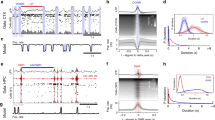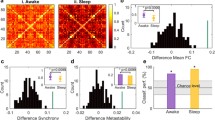Abstract
Rhythms at slow (<1 Hz) frequency of alternating Up and Down states occur during slow-wave sleep states, under deep anaesthesia and in cortical slices of mammals maintained in vitro. Such spontaneous oscillations result from the interplay between network reverberations nonlinearly sustained by a strong synaptic coupling and a fatigue mechanism inhibiting the neurons firing in an activity-dependent manner. Varying pharmacologically the excitability level of brain slices we exploit the network dynamics underlying slow rhythms, uncovering an intrinsic anticorrelation between Up and Down state durations. Besides, a non-monotonic change of Down state duration is also observed, which shrinks the distribution of the accessible frequencies of the slow rhythms. Attractor dynamics with activity-dependent self-inhibition predicts a similar trend even when the system excitability is reduced, because of a stability loss of Up and Down states. Hence, such cortical rhythms tend to display a maximal size of the distribution of Up/Down frequencies, envisaging the location of the system dynamics on a critical boundary of the parameter space. This would be an optimal solution for the system in order to display a wide spectrum of dynamical regimes and timescales.







Similar content being viewed by others
References
Amit DJ (1989) Modeling brain function: the world of attractor neural networks. Cambridge university press, Cambridge
Amit DJ, Brunel N (1997) Model of global spontaneous activity and local structured activity during delay periods in the cerebral cortex. Cereb Cortex 7(3):237–252
Amit DJ, Tsodyks M (1991) Quantitative study of attractor neural network retrieving at low spike rates: I. substrate—spikes, rates and neuronal gain. Network 2:259–273
Beggs JM (2008) The criticality hypothesis: how local cortical networks might optimize information processing. Philos Transact A Math Phys Eng Sci 366(1864):329–343
Bertschinger N, Natschläger T (2004) Real-time computation at the edge of chaos in recurrent neural networks. Neural Comput 16(7):1413–1436
Braitenberg V, Schüz A (1991) Anatomy of the cortex: statistics and geometry. Springer, Berlin
Braun J, Mattia M (2010) Attractors and noise: twin drivers of decisions and multistability. Neuroimage 52(3):740–751
Brunel N, Hakim V (1999) Fast global oscillations in networks of integrate-and-fire neurons with low firing rates. Neural Comput 11:1621–1671
Burkitt AN (2006) A review of the integrate-and-fire neuron model: I. Homogeneous synaptic input. Biol Cybern 95:1–19
Compte A, Sanchez-Vives MV, McCormick DA, Wang X-J (2003) Cellular and network mechanisms of slow oscillatory activity (<1 Hz) and wave propagations in a cortical network model. J Neurophysiol 89(5):2707–2725
Cossart R, Aronov D, Yuste R (2003) Attractor dynamics of network UP states in the neocortex. Nature 423(6937):283–288
Curto C, Sakata S, Marguet S, Itskov V, Harris KD (2009) A simple model of cortical dynamics explains variability and state dependence of sensory responses in urethane-anesthetized auditory cortex. J Neurosci 29(34):10600–10612
Deco G, Rolls ET (2005) Synaptic and spiking dynamics underlying reward reversal in the orbitofrontal cortex. Cereb Cortex 15(1):15–30
Deco G, Martí D, Ledberg A, Reig R, Sanchez-Vives MV (2010) Effective reduced diffusion-models: a data driven approach to the analysis of neuronal dynamics. PLoS Comput Biol 5(12):e1000587
Destexhe A, Hughes SW, Rudolph M, Crunelli V (2007) Are corticothalamic ‘up’ states fragments of wakefulness? Trends Neurosci 30(7):334–342
Durstewitz D, Deco G (2008) Computational significance of transient dynamics in cortical networks. Eur J Neurosci 27(1):217–227
Fusi S, Mattia M (1999) Collective behaviour of networks with linear (VLSI) integrate-and-fire neurons. Neural Comput 11:633–652
Gigante G, Mattia M, Del Giudice P (2007) Diverse population-bursting modes of adapting spiking neurons. Phys Rev Lett 98:148101
Giugliano M, Darbon P, Arsiero M, Lüscher HR, Streit J (2004) Single-neuron discharge properties and network activity in dissociated cultures of neocortex. J Neurophysiol 92(2):977–996
Harris KD, Bartho P, Chadderton P, Curto C, de la Rocha J, Hollender L, Itskov V, Luczak A, Marguet SL, Renart A, Sakata S (2010) How do neurons work together? Lessons from auditory cortex. Hear Res 271(1–2):37–53
Holcman D, Tsodyks M (2006) The emergence of Up and Down states in cortical networks. PLoS Comput Biol 2(3):e23
Hopfield JJ (1982) Neural networks and physical systems with emergent collective computational abilities. Proc Natl Acad Sci USA 79(8):2554–2558
Koulakov AA, Raghavachari S, Kepecs A, Lisman JE (2002) Model for a robust neural integrator. Nat Neurosci 5(8):775–782
La Camera G, Giugliano M, Senn W, Fusi S (2008) The response of cortical neurons to in vivo-like input current: theory and experiment : I. Noisy inputs with stationary statistics. Biol Cybern 99:279–301
Langton C (1990) Computation at the edge of chaos: phase transitions and emergent computation. Physica D 42(1–3):12–37
Latham PE, Richmond BJ, Nelson PG, Nirenberg S (2000) Intrinsic dynamics in neuronal networks. I. Theory. J Neurophysiol 83(2):808–827
Lau P-M, Bi G-Q (2005) Synaptic mechanisms of persistent reverberatory activity in neuronal networks. Proc Natl Acad Sci USA 102(29):10333–10338
Luczak A, Barthó P, Harris KD (2009) Spontaneous events outline the realm of possible sensory responses in neocortical populations. Neuron 62(3):413–425
Machens CK, Romo R, Brody CD (2005) Flexible control of mutual inhibition: a neural model of two-interval discrimination. Science 307(5712):1121–1124
Martí D, Deco G, Mattia M, Gigante G, Del Giudice P (2008) A fluctuation-driven mechanism for slow decision processes in reverberant networks. PLoS One 3(7):e2534
Mattia M, Del Giudice P (2000) Efficient event-driven simulation of large networks of spiking neurons and dynamical synapses. Neural Comput 12(10):2305–2329
Mattia M, Del Giudice P (2002) Population dynamics of interacting spiking neurons. Phys Rev E 66:051917
Mejias JF, Kappen HJ, Torres JJ (2010) Irregular dynamics in up and down cortical states. PLoS One 5(11):e13651
Ngo H-VV, Köhler J, Mayer J, Claussen JC, Schuster HG (2010) Triggering up states in all-to-all coupled neurons. Europhys Lett 89:68002
Reig R, Mattia M, Compte A, Belmonte C, Sanchez-Vives MV (2010) Temperature modulation of slow and fast cortical rhythms. J Neurophysiol 103:1253–1261
Renart A, Brunel N, Wang X-J (2003) Mean-field theory of irregularly spiking neuronal populations and working memory in recurrent cortical networks. In: Feng J (ed) Computational neuroscience: a comprehensive approach. CRC Press, Boca Raton
Risken H (1989) The Fokker-Planck equation: methods of solution and applications, 2nd edn. Springer, Berlin
Sanchez-Vives MV, McCormick DA (2000) Cellular and network mechanisms of rhythmic recurrent activity in neocortex. Nat Neurosci 3:1027–1034
Sanchez-Vives MV, Descalzo VF, Reig R, Figueroa NA, Compte A, Gallego R (2008) Rhythmic spontaneous activity in the piriform cortex. Cereb Cortex 18(5):1179–1192
Sanchez-Vives MV, Mattia M, Compte A, Perez-Zabalza M, Winograd M, Descalzo VF, Reig R (2010) Inhibitory modulation of cortical up states. J Neurophysiol 104:1314–1324
Sasaki T, Matsuki N, Ikegaya Y (2007) Metastability of active CA3 networks. J Neurosci 27(3):517–528
Shu Y, Hasenstaub A, McCormick DA (2003) Turning on and off recurrent balanced cortical activity. Nature 423(6937):288–293
Spiridon M, Gerstner W (1999) Noise spectrum and signal transmission through a population of spiking neurons. Network 12:409–421
Steriade M, Nunez A, Amzica F (1993) A novel slow (<1 Hz) oscillation of neocortical neurons in vivo: depolarizing and hyperpolarizing components. J Neurosci 13(8):3252–3265
Tsuda I (2002) Toward an interpretation of dynamic neural activity in terms of chaotic dynamical systems. Behav Brain Sci 24(5):793–810
van Vreeswijk C, Hansel D (2001) Patterns of synchrony in neural networks with spike adaptation. Neural Comput 13(5):959–992
Wang XJ (2002) Probabilistic decision making by slow reverberation in cortical circuits. Neuron 36(5):955–968
Zipser D, Kehoe B, Littlewort G, Fuster J (1993) A spiking network model of short-term active memory. J Neurosci 13(8):3406–3420
Acknowledgments
We want to thank M. Perez-Zabalza, V.F. Descalzo and R. Reig for their contribution. This work was supported by a Ministerio de Ciencia e Innovación (MICINN) grant (BFU2008-01371/BFI) to MVSV.
Author information
Authors and Affiliations
Corresponding author
Rights and permissions
About this article
Cite this article
Mattia, M., Sanchez-Vives, M.V. Exploring the spectrum of dynamical regimes and timescales in spontaneous cortical activity. Cogn Neurodyn 6, 239–250 (2012). https://doi.org/10.1007/s11571-011-9179-4
Received:
Revised:
Accepted:
Published:
Issue Date:
DOI: https://doi.org/10.1007/s11571-011-9179-4




